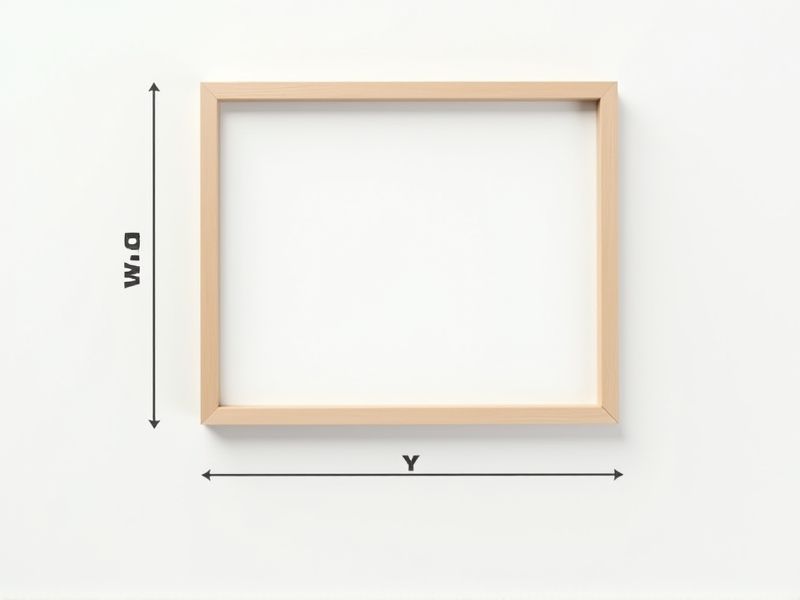
When choosing a photo frame, it's helpful to know the most common standard dimensions, so your prints fit perfectly. Popular photo frame sizes include 4x6 inches, 5x7 inches, and 8x10 inches, which are ideal for small to medium photographs. For larger displays, frames typically come in 11x14 inches, 16x20 inches, or even 24x36 inches. Checking these standard sizes ensures your photos are easy to print, and you'll have plenty of framing options to suit your decor.
Aspect Ratio
Aspect ratio is a crucial element in photo frame design, influencing how images are displayed and perceived. Common aspect ratios include 4:3, ideal for portraits, and 16:9, which is often used for widescreen formats. Choosing the right aspect ratio can enhance your artwork's visual appeal, ensuring that it fits seamlessly within your space. When selecting a frame, consider the aspect ratio that best complements your photography style and the intended display environment.
Mat Size
The standard photo frame dimensions typically include sizes like 4x6 inches, 5x7 inches, and 8x10 inches, catering to various display preferences. Mat sizes usually exceed the photo dimensions, providing a border that enhances visual appeal; for example, an 8x10 photo often fits into a frame with a mat measuring 11x14 inches. The mat's thickness can also impact the overall presentation, with common widths around 2 to 4 inches, designed to create a balanced look. Choosing the right mat size not only protects your image but also elevates its significance in your space.
Border Width
The standard border width for photo frames typically ranges from 1 inch to 3 inches, providing a balanced aesthetic for various artwork dimensions. A narrower border of around 1 inch suits smaller photographs, while a width of 2 to 3 inches enhances larger pieces by drawing the eye inward, emphasizing the image. Custom frames may offer borders exceeding 3 inches, allowing for a more dramatic presentation. When selecting a frame, consider that the border width significantly influences the overall visual impact and can complement your decor style.
Frame Thickness
Frame thickness significantly impacts the overall aesthetics and durability of a photo frame, with standard thicknesses typically ranging from 0.5 inches to 1.5 inches. A thicker frame often provides enhanced support and can better protect your artwork, while a thinner frame may lend a more contemporary and sleek appearance. When selecting a frame, consider how the thickness complements the dimensions of your photo, as well as your decor style, whether it's traditional or modern. Your choice of frame thickness can create a striking focal point for your artwork, enhancing its presentation and ensuring it stands out in any environment.
Glass Coverage
A quality photo frame should ideally feature glass coverage that fully protects the artwork while enhancing its visual appeal. Standard sizes typically range from 4x6 inches to 24x36 inches, accommodating various photographs and artwork. UV-filtered glass options are recommended to prevent fading and preserve the vibrancy of your images over time. When selecting a frame, consider styles that offer shatter-resistant or non-glare glass for added durability and clarity.
Mount Style
The Mount Style photo frame typically features a sleek, contemporary design that highlights the image within. This frame is available in various sizes, including 4x6, 5x7, and 8x10 inches, catering to different display preferences. Its construction often uses lightweight materials like MDF or acrylic, enhancing portability while maintaining durability. For optimal aesthetics, the frame can be paired with minimalist decor, allowing your favorite photos to take center stage.
Backing Material
The backing material of a photo frame plays a crucial role in ensuring the longevity and protection of your photographs. Common options include cardboard, foam board, and wood, each offering varying degrees of durability and aesthetics. For example, acid-free cardboard prevents deterioration and yellowing, while foam board provides lightweight support and insulation against moisture. Investing in high-quality backing material can significantly enhance the overall look and lifespan of your framed artwork or cherished pictures.
Corner Design
The corner design of a photo frame significantly enhances its aesthetic appeal and structural integrity. Specifically, modern frames often utilize mitered corners, which create a seamless connection between the edges, ensuring a professional finish. This design minimizes visible joints, giving the frame a polished look that perfectly complements your artwork or photographs. Selecting a frame with such a design can elevate the presentation of your images, making each corner a subtle yet impactful detail in your decor.
Hanging Hardware
When selecting a photo frame, it's essential to consider the hanging hardware, which directly affects installation and stability. Many frames come with D-rings, wire hangers, or sawtooth brackets, with dimensions typically ranging from 2 to 3 inches apart for optimal weight distribution. The hardware should support the weight of the frame, ensuring it can hold images up to 24 by 36 inches securely, without risk of damage. Quality hanging systems are often rated for weight capacities, such as 20 pounds for small or medium frames, giving you peace of mind when displaying your cherished memories.
Orientation Options
Photo frames are available in various orientation options, including vertical and horizontal formats, catering to diverse display preferences. The standard sizes typically range from 4x6 inches to 24x36 inches, ensuring a perfect fit for your cherished photographs. When selecting a photo frame, consider the aspect ratio of the image, with common ratios being 2:3 for portraits and 3:4 for landscapes. Choosing the right orientation not only enhances the visual appeal of your space but also complements the aesthetic of your artwork.
